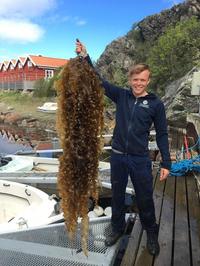
Exploring a multi-trophic aquaculture system containing non-fed species
Short description
The focus of my research is exploring the potential for a multi-trophic aquaculture involving extractive, or non-fed, species. Multi-trophic aquaculture is a method of food production whereby species from different trophic levels are grown in association with each other. The aim of this is to increase the yields of the system via the recycling of nutrients between species, resulting in more efficient growth as well as a decrease in the release of potentially harmful nutrients.
Whilst most aquaculture systems tend to focus on a species that requires feeding, such as salmon, my aim is to research the potential for combining non-fed species in a multi-trophic system. At present, I am working to co-cultivate the blue mussel (Mytilus edulis), an important aquaculture species in Sweden, with seaweeds such as the sugar kelp (Saccharina latissima).
Filter feeding species, such as the blue mussel, acquire their food from naturally occurring organic particles and phytoplankton in the water column and so do not require an extra source of feed. However, whilst they feed efficiently on natural particles, they also release nutrients such as ammonium and phosphate. These nutrients are crucial in the growth of seaweeds and in some circumstances can be limiting factors in seaweed growth. As such, there is potential for growing seaweeds in association with mussels or other filter feeding species to capitalize on this valuable nutrient source, and to prevent the accumulation of ammonium in the coastal marine environment which can potentially contribute to local eutrophication.
Taking this further, I also aim to explore how such multi-trophic systems can increase the resilience of the species involved to environmental stressors such as fluctuations in salinity. Ammonium, a form of dissolved nitrogen, is a precursor to amino acids and proteins. By growing seaweeds in conditions with enhanced ammonium it is possible that there will be more resources for maintenance meaning a higher resilience to environmental stressors.
To explore this area I am using a combination of field and laboratory studies to determine the interaction between these species and the potential to develop this into a larger scale food production system.
Participating researcher
Luca Rugiu, Department of Marine Sciences
